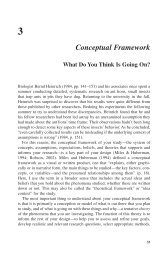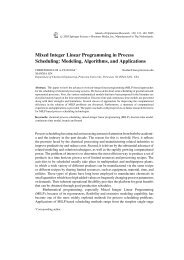Qualitative Research Basics: A Guide for Engineering Educators
Qualitative Research Basics: A Guide for Engineering Educators
Qualitative Research Basics: A Guide for Engineering Educators
Create successful ePaper yourself
Turn your PDF publications into a flip-book with our unique Google optimized e-Paper software.
• Conceptualization: Given the inductive nature of qualitative studies, the<br />
conceptual framework is viewed more tentatively than it is in traditional studies.<br />
The emphasis is on discovery and understanding, so energy devoted in advance to<br />
specifically describing the topic of interest, defining variables, and modeling it in<br />
terms of established theories is regarded as potentially hampering the researcher<br />
from seeing it in a new light. At the same time, it is important <strong>for</strong> the researcher to<br />
articulate his or her assumptions about the topic and the ways in which it is being<br />
approached. For example, thinking of incoming students as “underprepared” is<br />
not the same of thinking of them as “differently prepared.” Understanding<br />
teaching as “in<strong>for</strong>mation transmission” is different from seeing it as “facilitating<br />
student engagement in learning.” When the researcher spends some time<br />
articulating how he or she thinks about the topic and its context, the questions and<br />
methods of the study are more intentional.<br />
• Choice of tradition: As described in Chapter 2, there are a variety of approaches<br />
and traditions that qualitative researchers use. Deciding whether the research<br />
questions lend themselves to a phenomenological approach, an ethnography, a<br />
grounded theory study, or some other <strong>for</strong>m is the next design task.<br />
• Literature review: As with the conceptualization, there are some qualitative<br />
researchers who argue that working from previous scholarship might prevent the<br />
researcher from looking at the phenomenon of interest with fresh eyes.<br />
Approaches, arguments, and findings of other researchers can rein<strong>for</strong>ce the taken<strong>for</strong>-granted.<br />
However, most scholars believe in the importance of building on<br />
each other’s work and recommend that qualitative researchers explore the major<br />
types of studies that have been conducted in the area in which they are doing<br />
research. Unlike other researchers, however, qualitative researchers often broaden<br />
their literature review while they are gathering data and during analysis as new<br />
ideas and connections emerge. As with other literature reviews, this activity is<br />
situated as an argument: what has been studied that is pertinent to my topic and<br />
why is my study still needed?<br />
• Data collection strategies: To describe how the research topic will be explored,<br />
the qualitative researcher next has to detail methods <strong>for</strong> data collection and<br />
sampling.<br />
o Methods: These are described in Chapter 4 of this handbook. It is important to<br />
delineate in a research plan the answers to some basic questions <strong>for</strong> each type<br />
of method. For example,<br />
o If observation:<br />
� Entry (How will I gain access to the site and gain trust?)<br />
� Stance (Will I be a participant, observer, or both?)<br />
� Way of recording (Will I use audiotape, videotape, notes, all?)<br />
o If interviewing:<br />
18
















